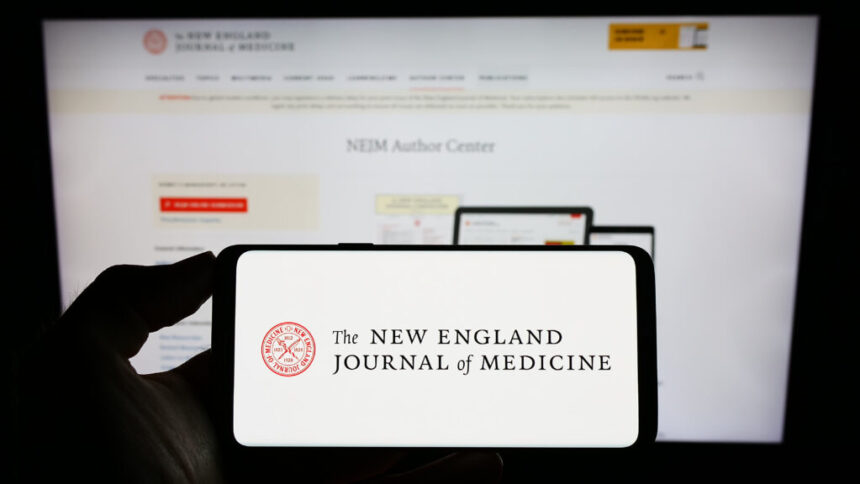The New England Journal of Medicine, the world’s oldest continually published medical journal, publicly reckoned with its history and complicity surrounding slavery and racism Wednesday, publishing the first of a series of essays by independent historians on the role the prestigious publication has played in perpetuating racist thinking in medicine that continues to this day.
In their essay, the historians describe the journal, founded in 1812, as “bound to slavery” because the families of one of the journal’s founders, James Jackson, had owned enslaved people and benefited financially from the slave trade, and the other founder, John Collins Warren, came from a family that also enriched itself through trade closely tied to slavery.
The historians provided evidence that throughout the 19th century, authors routinely and casually used racist and dehumanizing language about Black Americans in the journal with little pushback from editors and that in the same time period, the editors reprinted articles from Southern medical journals filled with racist ideology about the intelligence and health of Black Americans.
The journal did little to question the institution of slavery, the historians noted. While slavery was illegal in Massachusetts when the journal was founded there, it did not end throughout the nation until the mid-1860s.
The analysis shows the journal provided a highly prominent forum for physicians to perpetuate ideas rooted in racism and white supremacy even after the Civil War and into the early 20th century, said David S. Jones, a professor of the culture of medicine at Harvard who sparked and is helping oversee the project.
The authors added that those beliefs continue to fuel health disparities faced by Black Americans.
“History matters,” said Evelynn Hammonds, a professor of the history of science at Harvard University and one of the essay’s authors. “Not everybody gets the same health care in America. How did we get a system like that? It didn’t just pop up from nowhere.”
Jones said he was attending a seminar last year related to a Harvard project interrogating the university’s relationship with slavery when he heard a seminar by Boston University race scholar Ibram X. Kendi about an 1842 article in the journal arguing that slavery enhanced the mental health of African Americans.
The article stated that Census statistics showed insanity was 10 times higher among free Black Americans in the north than in enslaved Black people and proclaimed “slavery has a wonderful influence upon the development of moral faculties and the intellectual powers.”
It turns out the Census statistics were completely wrong; some towns had listed more insane Black people in their populations than there were Black people in total. The author, Edward Jarvis, retracted the article two months later, but the damage had been done. In 1844, the U.S. Secretary of State used the notion that slavery was beneficial and prevented insanity to argue for annexing Texas as a slave state, the authors wrote.
Jones said he was so startled by the talk that he sent an email to journal editors while still in the seminar asking if they would examine the Jarvis article and other ways the journal had been complicit in slavery.
“I wasn’t expecting them to take this seriously, but to their credit they did,” he said, adding that the journal relaxed its normally strict length limits so the historians could thoroughly investigate the journal’s 200-year archive and probe how decisions made by the highly influential journal may still percolate through medical care today.
“It’s easy to say we would never do that now. The situation now may not be as overt, and the language may not be as crude, but the country and medical institutions are still grappling with this very old legacy,” Jones told STAT.
In a number of articles the journal published, medical treatment of enslaved people was primarily intended to keep them fit for labor: One article described an ill woman as having “been able to labor but little for two years,” while another described a man with testicular tuberculosis as “useless to his owners.” The historians decided not to include the inflammatory and crude language of the day, saying it was too toxic and hateful to be reprinted and could also overshadow the more subtle racism that persists in medicine today.
“These were not people the white physicians had to care about,” Hammond said. “The laws changed, but did the ideas?”
The journal’s reckoning with its past follows similar projects at numerous universities, from Brown University, which was among the first institutions to publicly catalog its relationship with slavery in 2003, to Virginia Commonwealth University, which is studying, memorializing, and reburying the bones of more than 50 Black Americans whose bones were found in an abandoned well after being discarded by medical staff in the 1800s.
The essay was lauded by Rachel Hardeman, who directs the Center for Antiracism Research for Health Equity at the University of Minnesota and has been published in NEJM but also been a vocal critic of the ways medical journals avoid addressing institutional racism.
“This is an incredible grounding in the history and makes those connections between the history of chattel slavery and medicine. It’s one of the most comprehensive pieces I’ve seen in a medical journal,” Hardeman said. “I want to be careful about patting NEJM on the back and saying ‘Good job.’ But really, good job.”
In 2021, the American Medical Association released an 83-page report chronicling racism and white supremacy within its own walls, including its decision to exclude Black physicians for more than a century and to pay little attention to how racism has impacted medicine and caused health disparities. The report was in the works for some time, but its release followed outcry over a JAMA podcast that questioned whether structural racism exists in medicine and a promotional tweet by that journal that proclaimed “no physician is racist.”
It’s physicians who think and say they treat all their patients the same that are a target of these essays, Jones said. “Someone who says no doctor is racist is probably burying their head in the sand,” he said. “Many people have biases they don’t know about.”
Scott Podolsky, a co-organizer of the series and Harvard professor who directs the Center for Medical History at the university’s Countway Medical Library, said he was surprised to learn the journal had not taken more of a public stance against slavery and had published egregious content. For example, it reprinted an article in 1843 that claimed white and Black people were distinct species and favorably reviewed 19th century ideas about craniometry, or skull capacity, which stated that Black people were inferior.
“It’s easy to say this was all coming out of southern journals, but no, here’s a northern journal perpetuating these ideas,” he said. “You can invoke J. Marion Sims (the father of gynecology who operated on enslaved women without anesthetic) and Tuskegee and leave it at that, but the value of this work shows just how common racism was.”
That racism “showed up time and time again” in the journal’s archives, Jones said, from a 1904 article suggesting that slavery helped prevent Black people from getting tuberculosis to a critique of hospital desegregation written by a white physician during the 1960s civil rights movement.
“It still shows up in health disparities articles even now” that blame people’s biology, rather than social conditions, for illnesses, said Hammond. But the authors also said they thought the appearance of racist ideas in medical journals was declining with time and growing awareness.
Jones said the team tried to determine, but could not, when the journal first published an article by a Black author. He said the lack of diversity in article authors remained an issue throughout medical publishing and said he’d like to see medical journals publish data on the race of authors who submit articles compared to the race of authors whose submissions are published to see if there are disparities.
Editors of the New England Journal of Medicine declined to answer questions from STAT about specific steps they were taking to eradicate bias and confront what the new essay unearthed, but the journal’s editor-in-chief, Eric Rubin, said in a statement journal leaders were “acknowledging our past mistakes with the hope of preventing new ones.” The journal has committed to combating systemic racism as a public health and human rights crisis and to educating the medical community about its effects.
The journal will publish six additional essays, one each month, on other topics including how editors have treated Indigenous Americans, the eugenics movement, Nazi-era medicine, divisive articles the journal published during the civil rights era, and gender bias. Even seven essays are “just scratching the surface,” Jones said, adding that he hoped other historians would write about antisemitism, bias against Hispanic people, and how medicine has treated homosexuality, among other topics.
“Medical institutions have an enormous amount of work to do to dig themselves out of the hole they put themselves in,” he said. “We have to be aware of that every day.”









